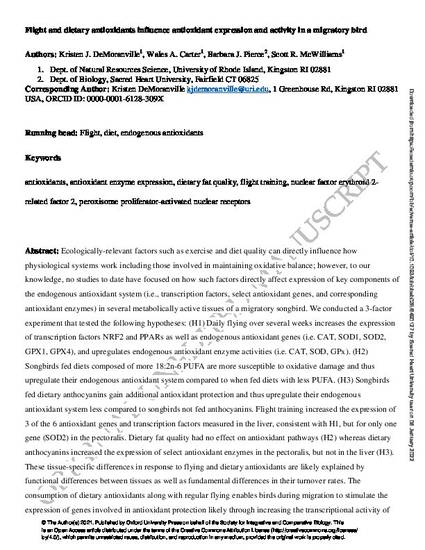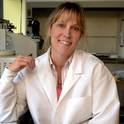
Ecologically-relevant factors such as exercise and diet quality can directly influence how physiological systems work including those involved in maintaining oxidative balance; however, to our knowledge, no studies to date have focused on how such factors directly affect expression of key components of the endogenous antioxidant system (i.e., transcription factors, select antioxidant genes, and corresponding antioxidant enzymes) in several metabolically active tissues of a migratory songbird. We conducted a 3-factor experiment that tested the following hypotheses: (H1) Daily flying over several weeks increases the expression of transcription factors NRF2 and PPARs as well as endogenous antioxidant genes (i.e., CAT, SOD1, SOD2, GPX1, GPX4), and upregulates endogenous antioxidant enzyme activities (i.e., CAT, SOD, GPx). (H2) Songbirds fed diets composed of more 18:2n-6 PUFA are more susceptible to oxidative damage and thus upregulate their endogenous antioxidant system compared to when fed diets with less PUFA. (H3) Songbirds fed dietary anthocyanins gain additional antioxidant protection and thus upregulate their endogenous antioxidant system less compared to songbirds not fed anthocyanins. Flight training increased the expression of 3 of the 6 antioxidant genes and transcription factors measured in the liver, consistent with H1, but for only one gene (SOD2) in the pectoralis. Dietary fat quality had no effect on antioxidant pathways (H2) whereas dietary anthocyanins increased the expression of select antioxidant enzymes in the pectoralis, but not in the liver (H3). These tissue-specific differences in response to flying and dietary antioxidants are likely explained by functional differences between tissues as well as fundamental differences in their turnover rates. The consumption of dietary antioxidants along with regular flying enables birds during migration to stimulate the expression of genes involved in antioxidant protection likely through increasing the transcriptional activity of NRF2 and PPARs, and thereby demonstrates for the first time that these relevant ecological factors affect the regulation of key antioxidant pathways in wild birds. What remains to be demonstrated is how the extent of these ecological factors (i.e., intensity or duration of flight, amounts of dietary antioxidants) influences the regulation of these antioxidant pathways and thus oxidative balance.
DeMoranville, K. J., Carter, W. A., Pierce, B. J., & McWilliams, S. R. (2021). Flight and dietary antioxidants influence antioxidant expression and activity in a migratory bird. Integrative Organismal Biology, 4(1), obab035. Doi: 10.1093/iob/obab035
